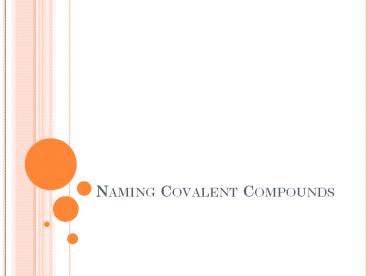Naming Covalent Compounds - PowerPoint PPT Presentation
1 / 5
Title:
Naming Covalent Compounds
Description:
NAMING COVALENT COMPOUNDS WRITING COVALENT COMPOUNDS Made of two anions (2 nonmetals or 1 nonmetal & 1 polyatomic ion) Identify the less electronegative element 1st ... – PowerPoint PPT presentation
Number of Views:226
Avg rating:3.0/5.0
Title: Naming Covalent Compounds
1
Naming Covalent Compounds
2
Writing Covalent Compounds
- Made of two anions (2 nonmetals or 1 nonmetal 1
polyatomic ion) - Identify the less electronegative element 1st
(trend less EN is the one farthest left
farthest down on Periodic Table) - The 1st nonmetal is just given the name as found
on the Periodic Table (just like ionic) - The 2nd nonmetal ending is changed to ide (just
like ionicdont change polyatomics) - Difference numerical prefixes are used to
express how many of each nonmetal are present
3
Writing Covalent Compounds (cont.)
- You never use criss-cross method
- The only time you do not use a prefix is when
there is only one of the first nonmetal.
4
Covalent Compound Practice
- SO2
- N2O
- NO2
- CCl4
- Cl2O7
- PCl3
- SF6
- Si3N4
- N(BrO3)5
- H2O
- Sulfur Dioxide
- Dinitrogen Monoxide
- Nitrogen Dioxide
- Carbon Tetrachloride
- Dichlorine Heptaoxide
- Phosphorus Trichloride
- Sulfur Hexaflouride
- Trisilicon Tetranitride
- Nitrogen Pentabromate
- Water ? - can use common name
5
Covalent Compound Practice
- Phosphorus Trioxide
- Dinitrogen Pentacarbide
- Tellurium Noniodide
- Carbon Monoxide
- Selenium Heptaflouride
- Tetraphosphorous Decoxide
- Arsenic Hexabromide
- Silicon Dichloride
- PO3
- N2C5
- TeI9
- CO
- SeF7
- P4O10
- AsBr6
- SiCl2































